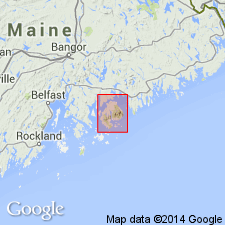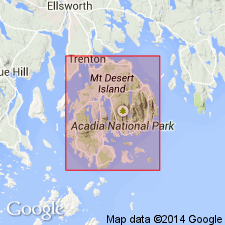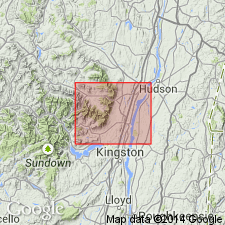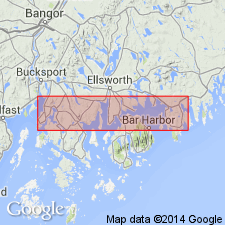
- Usage in publication:
-
- Cranberry Island series
- Modifications:
-
- Original reference
- Dominant lithology:
-
- Volcanics
- AAPG geologic province:
-
- New England province
Summary:
Pg. 1037, 1042-1047, 1059, 1061, and map. On north border of Little Cranberry Island we have a series of siliceous flaggy layers, which are probably closely related to the stratified rocks of Sutton's Island [see Sutton Island series]. The section is not over 100 feet thick, but it probably occupies a considerable area beneath the surface of the strait which separates the two islands. Above this we find a very extensive series of volcanic rocks, which have a thickness of at least 2,000 feet; to which I give the name of Cranberry Island series. At their contact with Sutton's Island series the volcanic beds of Cranberry Islands consist of porphyries, breccias, and amygdaloids, all apparently bedded, probably by a succession of lava flows and volcanic ash showers. On Cranberry Island we find essentially a repetition of the section shown on Little Cranberry Island, with exception that proportion of clay slates and bedded quartzites is much larger than the volcanic materials, and the schists and slates are more distinctly mingled with the igneous materials. [Map explanation states: "Cranberry Island series essentially the same as the Sutton Island series [which he assigned to Cambrian or pre-Cambrian] with many beds of volcanic ash."] No fossils. Age is Cambrian or pre-Cambrian.
Named from development in Great Cranberry and Little Cranberry Islands, south of Mount Desert Island, southeastern ME.
Source: US geologic names lexicon (USGS Bull. 896, p. 538).

- Usage in publication:
-
- Cranberry Island series
- Modifications:
-
- Overview
- AAPG geologic province:
-
- New England province
Summary:
On the 1933 geologic map of Maine, by A. Keith, the rocks of Cranberry Islands and south part of Mount Desert Island are mapped as Devonian igneous, and the rocks of Sutton Island appear to be mapped as "igneous, mainly Carboniferous."
Source: US geologic names lexicon (USGS Bull. 896, p. 538).

- Usage in publication:
-
- Cranberry Island volcanic facies
- Modifications:
-
- Revised
- AAPG geologic province:
-
- New England province
Summary:
Pg. 1797. Considered a facies of the Frenchman Bay series (new). Interfingers with and is of same age as Bar Harbor detrital facies. Age is Silurian.
Source: US geologic names lexicon (USGS Bull. 1200, p. 974).

- Usage in publication:
-
- Cranberry Island volcanic facies
- Modifications:
-
- Areal extent
- AAPG geologic province:
-
- New England province
Summary:
Pg. 173. Cranberry Island volcanic facies. Consists of felsite (and porphyry) flows and ash beds with tuffs and amygdaloids. Developed extensively in the southern part of Mount Desert Island.
Source: US geologic names lexicon (USGS Bull. 1200, p. 974).

- Usage in publication:
-
- [Cranberry Island volcanic facies]
- Modifications:
-
- Age modified
- AAPG geologic province:
-
- New England province
Summary:
Pg. 1194 (table 1). Age is Middle or Late Silurian.
Source: US geologic names lexicon (USGS Bull. 1200, p. 974).
For more information, please contact Nancy Stamm, Geologic Names Committee Secretary.
Asterisk (*) indicates published by U.S. Geological Survey authors.
"No current usage" (†) implies that a name has been abandoned or has fallen into disuse. Former usage and, if known, replacement name given in parentheses ( ).
Slash (/) indicates name conflicts with nomenclatural guidelines (CSN, 1933; ACSN, 1961, 1970; NACSN, 1983, 2005, 2021). May be explained within brackets ([ ]).

